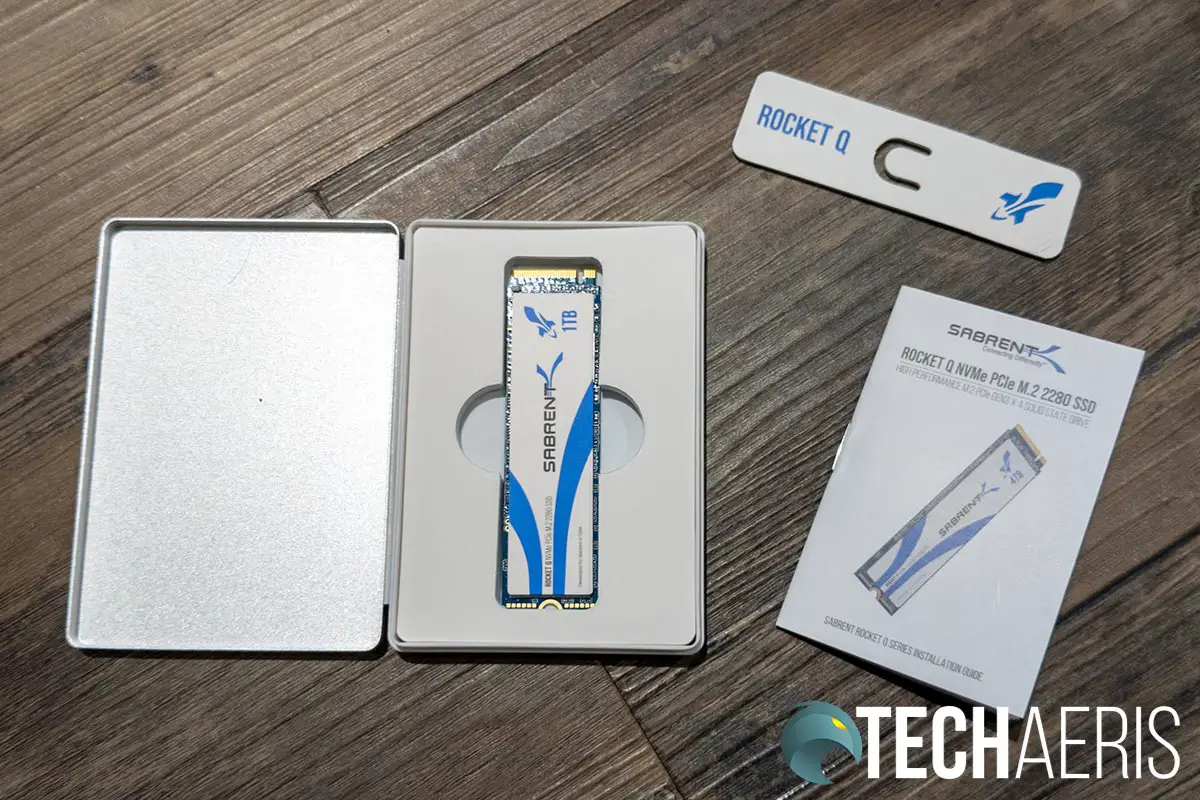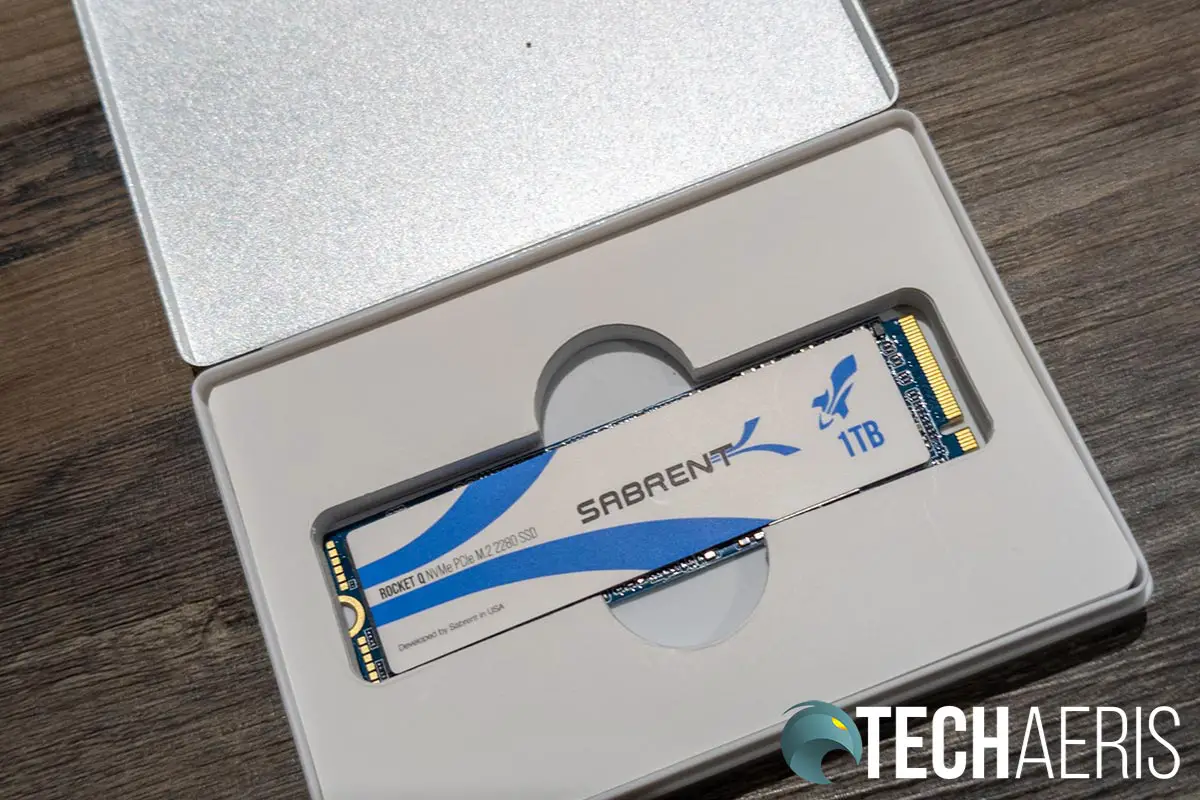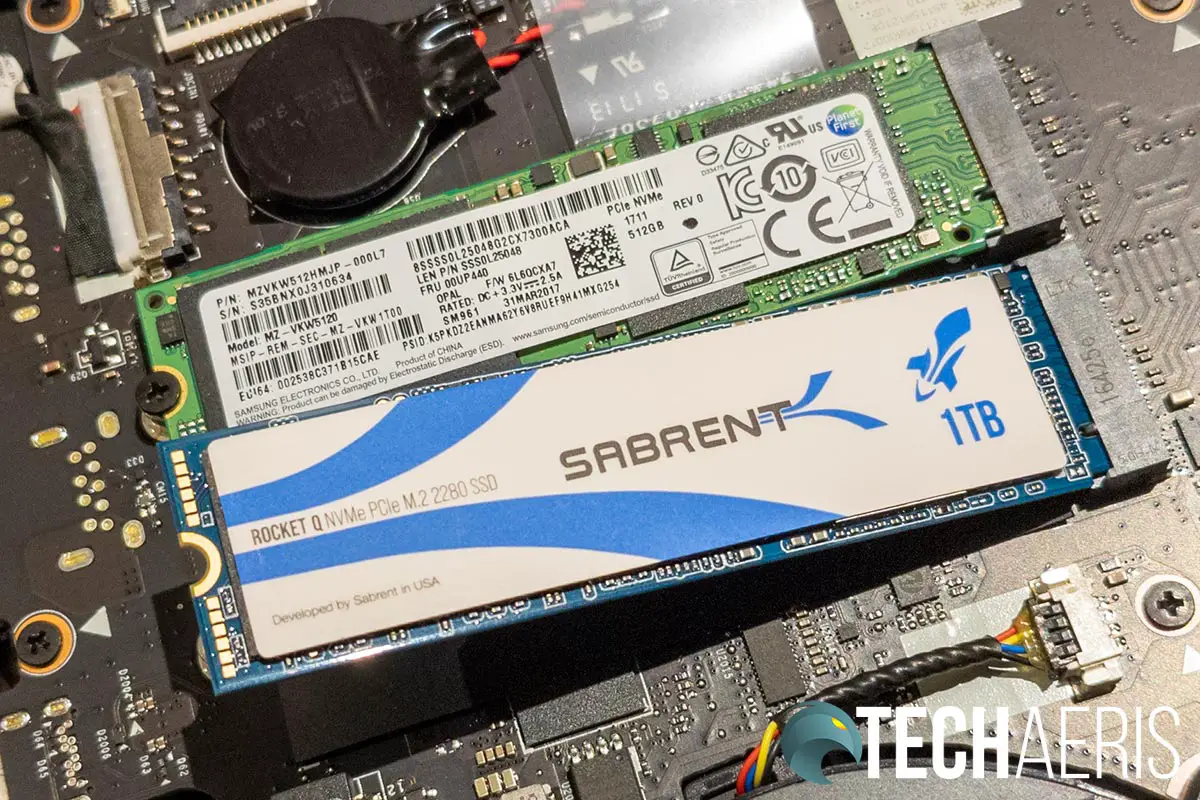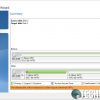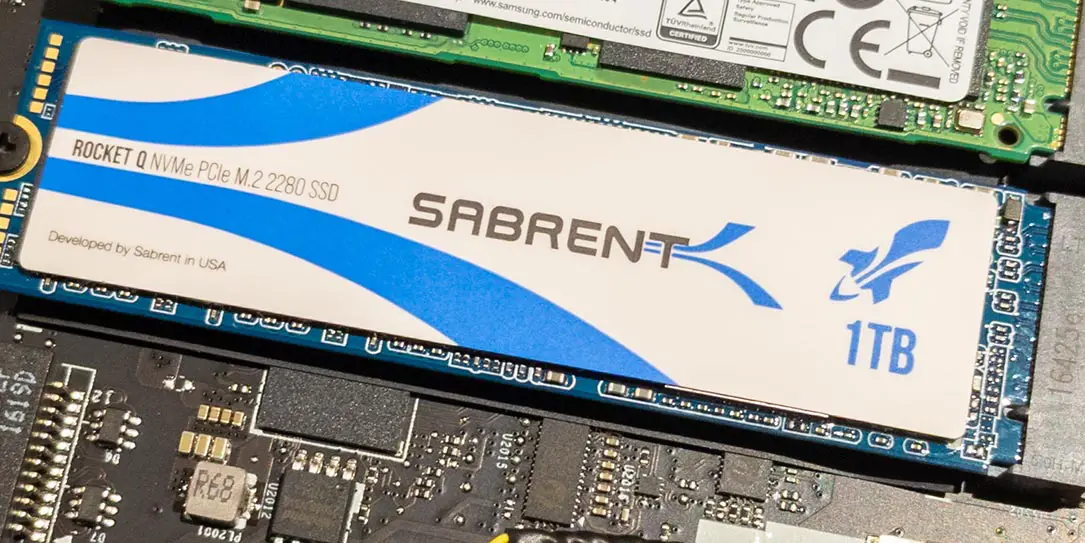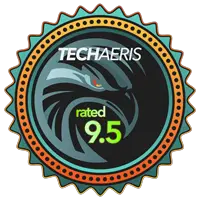
When one thinks of NVMe SSDs, bigger OEMs come to mind like Western Digital, Samsung, and Seagate. There are other manufacturers as well which offer up similar speeds, often at a much more affordable price. Sabrent is one such manufacturer, who coincidentally just announced the fastest NVMe 4.0 SSD.
Our Rocket Q 1TB SSD review takes a look at another NVMe SSD from Sabrent which features QLC NAND and read speeds of up to 3200MB/s and write speeds of up to 2000MB/s.
Specifications
The Sabrent Rocket Q 1TB SSD has the following features and specifications:
- M.2 PCIe Gen3 x 4 Interface
- PCIe 3.1 Compliant/NVMe 1.3 Compliant
- Power Management Support for APST / ASPM / L1.2
- Supports SMART and TRIM commands. Supports ONFi 2.3, ONFi 3.0, ONFi 3.2 and ONFi 4.0 interface
- All Sabrent SSDs come with FREE Sabrent Acronis True Image for Sabrent Software for easy Cloning
| Model | SB-RKTQ-1TB |
| Capacity | 1TB (500GB, 1TB, 2TB, 4TB, 8TB available) |
| Interface | PCIe Gen 3 x4, NVMe 1.3 |
| NAND | Micron QLC NAND |
| Flash Controller | Sabrent RKT 303 Controller |
| Max Sequential Read | 3200MB/s |
| Max Sequential Write | 2000MB/s |
| Random 4K QD32 (IOPS) Read | 125K |
| Random 4K QD32 (IOPS) Write | 500K |
| Power Consumption (R/W) | 5.0/4.5W |
| Power Supply | 3.3V |
| Form Factor | M.2 2280 |
| Operating Temperature | 0~70°C |
| MTBF | 1,800,000 |
| Shock Resistant | 1500G |
| Data Correction | LDPC |
| TBW | 260 |
| Dimensions | 2.25 x 22 x 80mm |
| Warranty | 5 years with registration |
What’s in the box
- Sabrent Rocket Q 1TB NVMe PCIe M.2 2280 SSD
- Installation Guide
- Acronis True Image Cloning Software
Design
Before we get to design, I just wanted to mention that the Sabrent Rocket Q 1TB NVMe SSD comes in a pretty nice aluminum pillbox style case. It definitely makes a decent first impression as opposed to just coming in a box padded in foam or some other basic packaging.
As far as design is concerned, there’s not much wiggle room when it comes to NVMe SSDs. Being the M.2 2280 form factor, the drive is slim and thin. Like other drives this size, it measures 0.09 inches thick by 0.87 inches wide and 3.15 inches in length. There is a notch at the top for a screw and a notch in the bottom connectors to ensure a proper fit inside your computer or laptop.
Unlike most NVMe SSDs which have some of the modules exposed, the Rocket Q has a sticker on both sides with Sabrent branding. The top has the Sabrent logo with the model name and size on it. The back, or bottom, contains other information like the model number and serial number.
Installation
Installing the Sabrent Rocket Q NVMe SSD into your desktop or laptop will vary by system. For a desktop, it will likely require unplugging your system, removing a couple of screws, a side panel, and then inserting it into a free M.2 slot.
We used a Lenovo Legion Y920 gaming laptop for our testing. As such, the installation was a bit more time consuming but easy nonetheless. After removing all the screws on the bottom of the laptop to access the internals, I simply slid the Rocket Q into the second M.2 slot, screwed it in place, and replaced the bottom panel.
If you only have one NVMe slot in your system and are upgrading, you’ll need to connect the Sabrent Rocket Q to your computer using an enclosure. You’ll want to read the next section as well which focuses on how to clone your existing drive to your new NVMe SSD.
Software
The Sabrent Rocket Q NVMe SSD comes with a complimentary copy of Acronis True Image Cloning Software which is available from the company’s website. Overall, Acronis True Image is straightforward, easy to use, and works just fine. Of note, while the application is freely available to download from Sabrent’s website, it will not function without a recognized Sabrent drive installed in or attached to your system.
There are six main tabs: Backup, Tools, Active Protection, Account, Settings, and Help. The Backup tab lets you create a disk image that you can restore at a later date. The Active Protection tab has some useful options as well, including measures to protect your system from ransomware and illicit cryptomining. Some of this is built into Windows 10 already, but extra protection can’t hurt these days.
If you’re upgrading your drive, the Tools section is likely where you’ll be spending most of your time in Acronis True Image. Here you have options like Clone Disk, Rescue Media Builder, Acronis Universal Restore, Try & Decide, Add New Disk, Acronis Secure Zone, and Acronis DriveCleanser. A few of these are locked, like Acronis Universal Restore, which presumably requires an upgrade to use.
I used the Clone Disk tool and it was as easy as a few clicks. Select Clone Disk and choose Automatic mode (unless you want more control over the clone but this is the easiest one for an exact clone of your existing drive). Next, choose your source and destination (the Sabrent Rocket Q) disk and accept the warning about data being erased on the destination disk. Finally, click finish and sit back while the drive clones. Once cloned, you’ll have to install the drive inside your computer (if not already installed), go into your BIOS, and set the default boot drive. This varies by system so we won’t cover that here. Once completed, fire up your computer and you should be good to go.
Acronis True Image Screenshot Gallery
Performance
NVMe M2.2280 SSDs tend to top out at around 3,500MB/s. The Sabrent Rocket Q 1TB is rated at 3,200MB/s read and 2,000MB/s write.
Because geeks love numbers, we ran a few disk benchmark tests, namely the one with the Samsung Magician SSD app, CrystalDiskMark, and finally AS SSD Benchmark. While we ran all tests against the Samsung 950 PRO and the WD Black SN750, we did run a few on a Samsung 840 EVO SSD (non-NVMe) drive for comparison.
| Samsung SSD 840 EVO | Samsung 950 PRO | WD Black SN750 | Sabrent Rocket Q 1TB | |
| Samsung Magician Seq Read | 489 MB/s | 2,441 MB/s | 3,219 MB/s | 3,096 MB/s |
| Samsung Magician Seq Write | 309MB/s | 1,248 MB/s | 2,952 MB/s | 2,021 MB/s |
| Samsung Magician IOPS Read | 52,001 | 109,619 | 118,896 | 74,462 |
| Samsung Magician IOPS Write | 16,601 | 95,458 | 104, 980 | 56,640 |
| CrystalDiskMark Seq Read | – | 2,964.1 MB/s | 3,367.5 MB/s | 3,355.7 MB/s |
| CrystalDiskMark Seq Write | – | 1,548.4 MB/s | 2,960.9 MB/s | 2,072.87 MB/s |
| AS SSD Seq Read | – | 2,783.59 MB/s | 2,876.66 MB/s | 2,635.71 MB/s |
| AS SSD Seq Write | – | 1,305.24 MB/s | 2,044.22 MB/s | 1,846.27 MB/s |
While benchmark numbers are nice, real world numbers are even better. After cloning the drive and setting it the boot drive, we measured boot time from when the Lenovo boot logo first showed up on the screen until you hit the Windows 10 login screen. For games, load time was measured from when we double-clicked the desktop icon to the first menu screen requiring user interaction.
| Samsung SSD 840 EVO | Samsung 950 PRO | WD Black SN750 | Sabrent Rocket Q | |
| Cold boot w/ fast boot enabled | 22.05s | 16.65s | 15.08s | 15.48s |
| Forza Horizon 4 | 65s | 43.95s | 40.53s | 41.06s |
| Forza Motorsport 7 | – | 32.46s | 30.13s | 30.55s |
| Gears of War 4 | – | 1m41.35s | 1m15.66s | 1m22.53s |
| Premiere Pro render (4m30s 1080p clip) | – | 2m45.22s | 2m31.38s | 2m40.79s |
As you can see, the Sabrent Rocket Q holds its own and performs rather well in real-world scenarios. Even though it has slower write speeds than is possible in an NVMe SSD, the difference in write time isn’t that bad in the grand scheme of things.
In addition, the Rocket Q also has Power Management Support for APST/ASPM /L1.2, SMART and TRIM commands, and ONFI (Open Nand Flash Interface) 2.3, 3.0, 3.2, and 4.0 interface.
Price/Value
While it is listed on Sabrent’s website for US$189.99, the 1TB option is currently listed with a regular price of $119.99 on Amazon. Based on the Sabrent price, it’s in line with other similar-sized NVMe SSDs, but based not the Amazon price it’s a great deal. You can also snag the 500GB for $69.99, the 2TB for $249.99, 4TB for $749.99, and the 8TB for a whopping $1999.99.
Wrap-up
While NVMe Gen 4 is much faster, there are plenty of systems out there that only support NVMe Gen 3. The Sabrent Rocket Q 1TB NVMe SSD offers up decent speeds at a very affordable price compared to other alternatives for those systems.
In some of our articles and especially in our reviews, you will find Amazon or other affiliate links. As Amazon Associates, we earn from qualifying purchases. Any other purchases you make through these links often result in a small amount being earned for the site and/or our writers. Techaeris often covers brand press releases. Doing this does not constitute an endorsement of any product or service by Techaeris. We provide the press release information for our audience to be informed and make their own decision on a purchase or not. Only our reviews are an endorsement or lack thereof. For more information, you can read our full disclaimer.
Last Updated on February 3, 2021.

